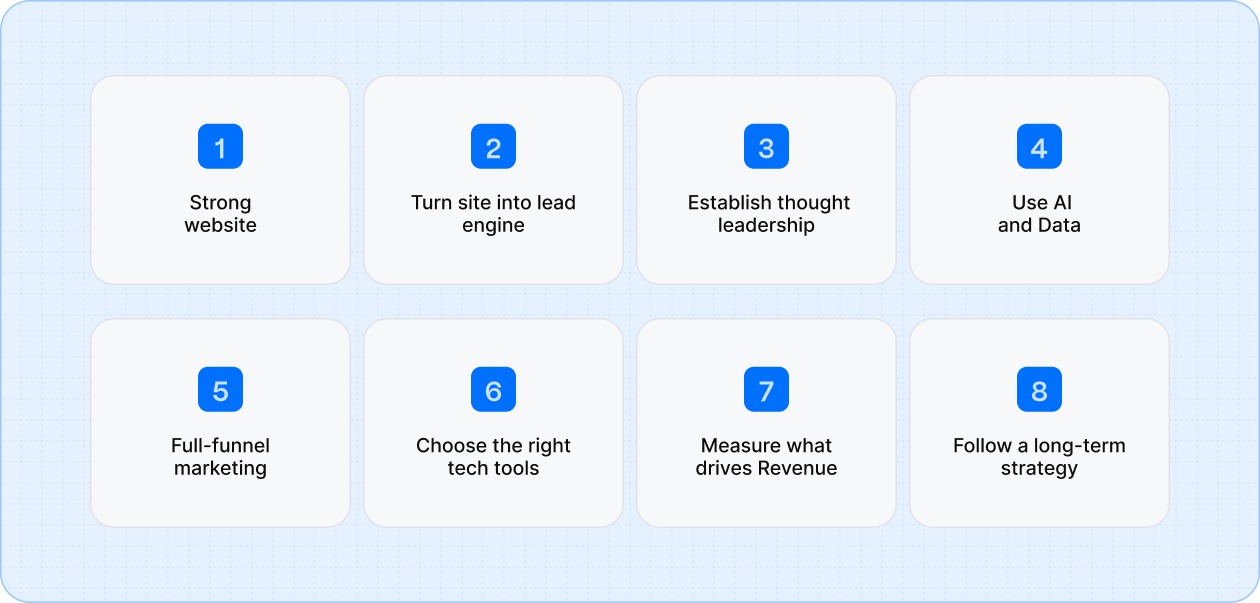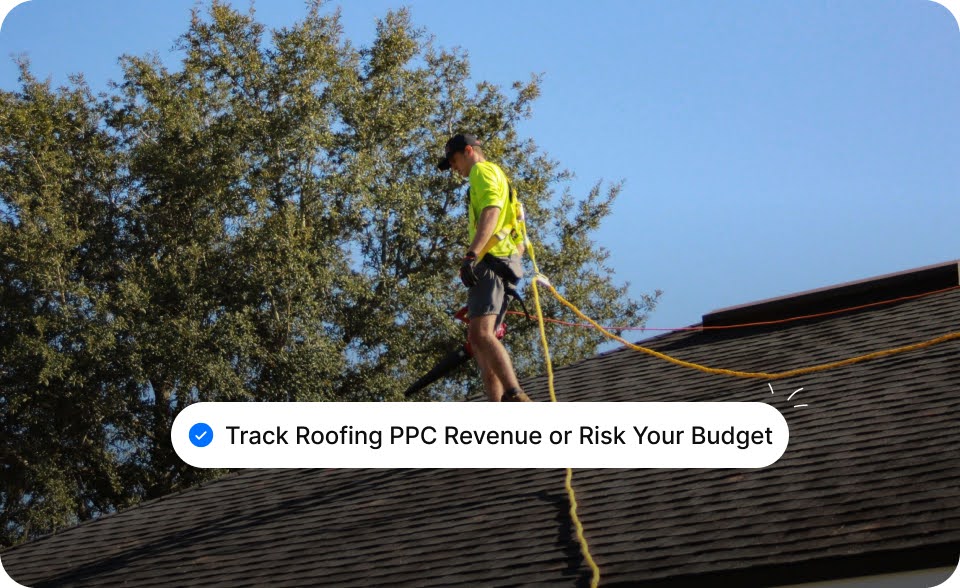Industrial manufacturing marketing is the practice of communicating and promoting your products, capabilities, and services to attract qualified buyers through multiple channels, both online and offline.
Done right, it puts your company in front of your buyers when they're actively looking.
In fact, 61% of manufacturing companies now measure marketing success through lead quality—because better leads mean faster revenue.
This guide covers 8 practical strategies to build a system that brings in consistent, high-quality leads. No complicated tasks, just proven moves for small-to-medium manufacturers.
Why Is Industrial Manufacturing Marketing Required?
One simple reason: your buyers can’t choose you if they can’t find you.
Research shows that 45% of B2B manufacturing buyers conduct online research before making a purchase. A good marketing strategy helps you do four things consistently:
- Get found when buyers look for your products.
- Get qualified by showing clear specs, industries served, and past work.
- Build trust through content, case studies, certifications, and technical expertise.
- Get contacted because buyers feel confident you can solve their problem.
When you market the right way, you shorten the sales cycle, attract better-fit leads, and turn your website into a consistent revenue engine—even without a full marketing team.
So what type of marketing should you start with?
Types of Industrial and Manufacturing Marketing You Must Know
There are two major types of marketing: digital and non-digital.
Digital marketing uses online channels, such as SEO, PPC ads, websites, email, Facebook, and LinkedIn, to help buyers find you when they search and to stay in touch with them throughout long sales cycles.
Non-digital marketing includes offline methods such as networking, trade shows, catalogs, referrals, billboards, print ads, cold outreach, and industry publications.
This is how each one of the channels can help:
Together, they create a strong system that compounds growth over time. Before you try everything at once, start with the strategies that actually move the needle.
8 Industrial Manufacturing Marketing Moves You Should Start Now

These are proven industrial manufacturing marketing strategies that work reliably for small-to-mid-sized manufacturers — simple enough to start tomorrow, strong enough to bring in better leads.
1. Build a High-Performing Website (Your #1 Sales Tool)
Your website is the one sales rep that never sleeps. It should clearly show what you make, what you’re capable of, who you serve, and how someone can request a quote in seconds. Most manufacturers lose leads simply because buyers can’t find basic information.
Why it works: Buyers won’t contact you unless they trust you.
How to start:
- Design a simple yet impactful website to convey to your buyers that you are a professional.
- Create clean, scannable pages like blogs, product pages, service pages, and capabilities pages.
- List specific details like tolerances, materials, industries, certifications, and machinery.
- Add clear Request a Quote buttons across the site.
- Use real process photos, videos, and customer logos.
- Add a simple “Why Work With Us” or case studies section to build credibility quickly.
What you get: Qualified leads and fewer “Can you do this?” calls because buyers understand your services before they reach out.
Your website is the first step in building a solid marketing strategy. Regular health checks can show how efficiently it’s working every day. See how your site performs today.
2. Become an Inbound Marketing Machine (Attract Buyers, Don’t Chase Them)
Inbound marketing means creating content and resources that pull buyers toward you rather than chasing them.
Industrial buyers don’t trust vendors by default. They need to know expertise, clarity, and proof. When your company consistently shows up with answers, insights, and helpful content, buyers qualify themselves before ever reaching out.
Why it works: Manufacturers conduct quiet research for weeks or months. If you’re the one educating them during this phase, you become the obvious choice when they’re ready.
How to start:
- Publish blogs that answer actual buyer questions (how-to guides, comparison articles, news and updates, FAQs, etc).
- Optimize every page for the keywords your buyers actually search for. (Use tools like Semrush and Ahrefs to find what your buyers are typing)
- Create capability explainers (“How ABC machining works,” “When to choose XYZ process”).
- Build a simple resource library: guides, datasheets, tooling notes, quality checklists.
What you get: A steady stream of inbound leads, fewer cold calls, and buyers who trust you before your first call.
3. Establish Thought Leadership (Authority = More Sales)
Thought leadership is when you establish yourself as an expert in a specific field by sharing original insights and innovative ideas.
In manufacturing, the vendor who teaches is usually the one who wins the project. Sharing your expertise, how things are made, what buyers should consider, and how you solve complex problems, is one of the easiest ways to capture more leads.
Why it works: Buyers pick partners who clearly understand tolerances, materials, workflows, and failures before they happen.
How to start:
- Share case studies that show a problem → your process → the result.
- Publish simple “How We Make ___” or “Design Tips for ___” explainers on your website or social media.
- Contribute articles to industry magazines and association websites.
- Post short, technical insights on LinkedIn (tooling tips, material choices, machining challenges) regularly.
What you get: Buyers see you as the expert. More trust, faster decisions, and quality conversions.
4. Use Data and AI to Accelerate Lead Generation
AI helps small manufacturing teams work like they have a full marketing department by automating follow-ups, prioritizing high-quality leads, and improving ad performance.
Why it works: Faster responses increase win rates, and data removes guesswork from your marketing.
How to start:
- Set up AI email or chatbot tools for instant replies to your leads (Hubspot or Zapier can help)
- Use AI insights to refine Ads targeting and budgets (Google Ads Smart Bidding / Performance Max are some tools that can help)
- Automate quoting steps or first-response workflows that read lead emails, extract specs, and instantly generate draft quotes or acknowledgment replies. (TIBR, StartProto, Salesforce CPQ are some tools that can help)
What you get: More qualified leads, faster conversions, and less manual effort slowing down your team.
5. Build a Full-Funnel Marketing System (Before, During, After Purchase)
Manufacturing industries deal with long sales cycles, multiple stakeholders, and slow decision-making. A full-funnel system keeps your buyers engaged from first contact to repeat order.
Why it works: Most manufacturers disappear after the first try. A full-funnel system keeps you top-of-mind, making you the safest and most familiar choice when they’re finally ready to place an order.
How to start:
- Add automated email sequences for prospects who downloaded a spec sheet, brochure, or visited key pages (Mailchimp or Hubspot CRM can help).
- Send project updates (progress photos, machining steps, QC checks) to build trust and transparency.
- Share capability upgrades (new CNC, new tolerance capacity, new materials you can machine).
- Create after-purchase nurturing. Ask for feedback, offer re-orders, and notify them of reorder cycles or maintenance reminders.
- Send helpful content like design tips, tolerance guides, material comparisons, or case studies regularly. Create WhatsApp groups to keep them engaged.
What you get: Stronger relationships, more repeat buyers, higher lifetime value, and predictable revenue, without relying only on new leads every month.
6. Choose the Right Tech (Without Wasting Budget)
Most manufacturers burn money on tools they never open. You don’t need 20 platforms; you need a lean stack that actually supports sales.
Why it works: When your tech is connected and straightforward, your team moves faster, and you stop paying for tools that collect dust.
How to start:
- Begin with only the essentials: CRM and Email (HubSpot), publishing content (WordPress), and tracking performance (Google Search Console)
- Skip tools that require a full-time marketer to operate
- Choose software that integrates with your website easily
- Increase your tech budget only after you see real ROI
What you get: A cleaner workflow, fewer subscriptions draining cash, and a tech stack that scales only when your business does.
7. Measure What Drives Revenue (Not Random Metrics)
Most manufacturers track website visitors and clicks, but leads and closed deals pay the actual bills. The goal is to focus on the numbers that directly influence revenue, not marketing noise.
Why it works: When you track the right signals, you finally see which marketing efforts actually drive customer acquisition (and which are wasting budget).
How to start:
- Identify the pages that directly generate sales.
- Track which keywords result in quotes, not just clicks
- Compare first-touch vs. last-touch to see what actually influenced the sale
- Double down on the channels that consistently lead to revenue conversations
What you get: A predictable, scalable sales pipeline built on real buyer behavior—not guesses.
8. Follow a Long-Term Marketing Strategy (Not Random Tactics)
Real industrial and manufacturing marketing growth doesn’t come from one-off posts or seasonal bursts. It comes from doing the right things every week, consistently.
Why it works: Marketing compounds over time. Changing strategies multiple times frequently will not help you track any success metrics. Stick to one solid strategy and double down on similar methods to perfect it.
How to start:
- Pick 3 core channels and commit (SEO + PPC + Email work best for SMB manufacturers)
- Set clear 90-day and 12-month goals. Define success here.
- Build weekly marketing routines your team can realistically follow.
- Review performance monthly and refine your approach.
What you get: Predictable lead flow, compounding results, and a marketing engine that gets stronger every quarter.
If you apply even half of these strategies consistently, you’ll start seeing what most manufacturers never do. Now the real question every owner eventually asks:
How Much Does Industrial Manufacturing Marketing Cost?
Before you invest in any marketing move, you need to know what it realistically costs in industrial and manufacturing marketing services.
Investing in the right mix of website, SEO, PPC, and content finally gives you control over your lead flow, not luck.
Suggested Read: 15+ Manufacturing SEO Companies That Drive Revenue
Who Can Handle Industrial Manufacturing Marketing For You?
If you don’t have a full marketing team, you can outsource this to:
- Industrial marketing agencies or manufacturing-specific marketing companies
- Freelancers who understand manufacturing content + technical SEO
- Revenue Growth Partners that handle end-to-end content execution, SEO, lead generation, and revenue growth.
- Your in-house sales and marketing team, once you give them the right tools + playbooks.
This way, you stay focused on production, while marketing runs in the background.
How a Closet-Door Maker Went from 0 to 113 Qualified Leads in 6 Months

Paniflex, a U.S.-based distributor of closet doors and mirror doors, had quality products, but no one knew about them. Their website wasn’t showing up for the searches real buyers were doing, so contractors, designers, and architects were finding only competitors.
Once Paniflex started publishing helpful, technically detailed content—specs, installation guides, and answers to buyer questions about closet door systems and track hardware—everything changed.
In six months, they attracted 113 qualified buyers without hiring a single salesperson.
Sales calls went from “what is this?” to “we have a requirement, what’s your quote?” Their visibility, authority, and pricing power rose simply because they became findable and credible at the moment buyers were searching.
But here’s the kicker: their success doesn’t end there. Because the content lives online, Paniflex keeps attracting new leads, silently, 24/7, while others are still shouting loudly and paying for ads.





















.webp)








.webp)
.svg)


.svg)
.svg)
.svg)







.svg)